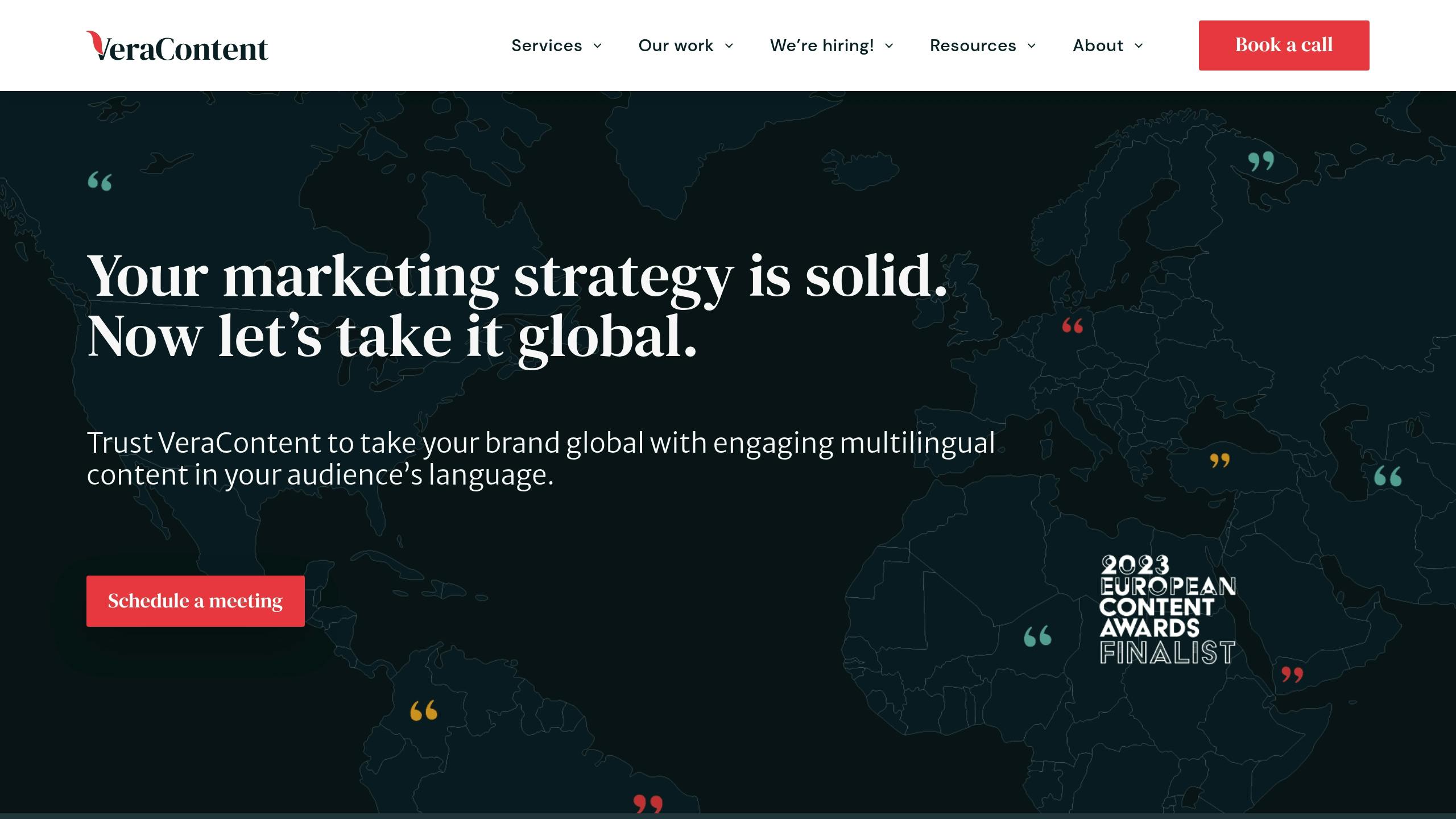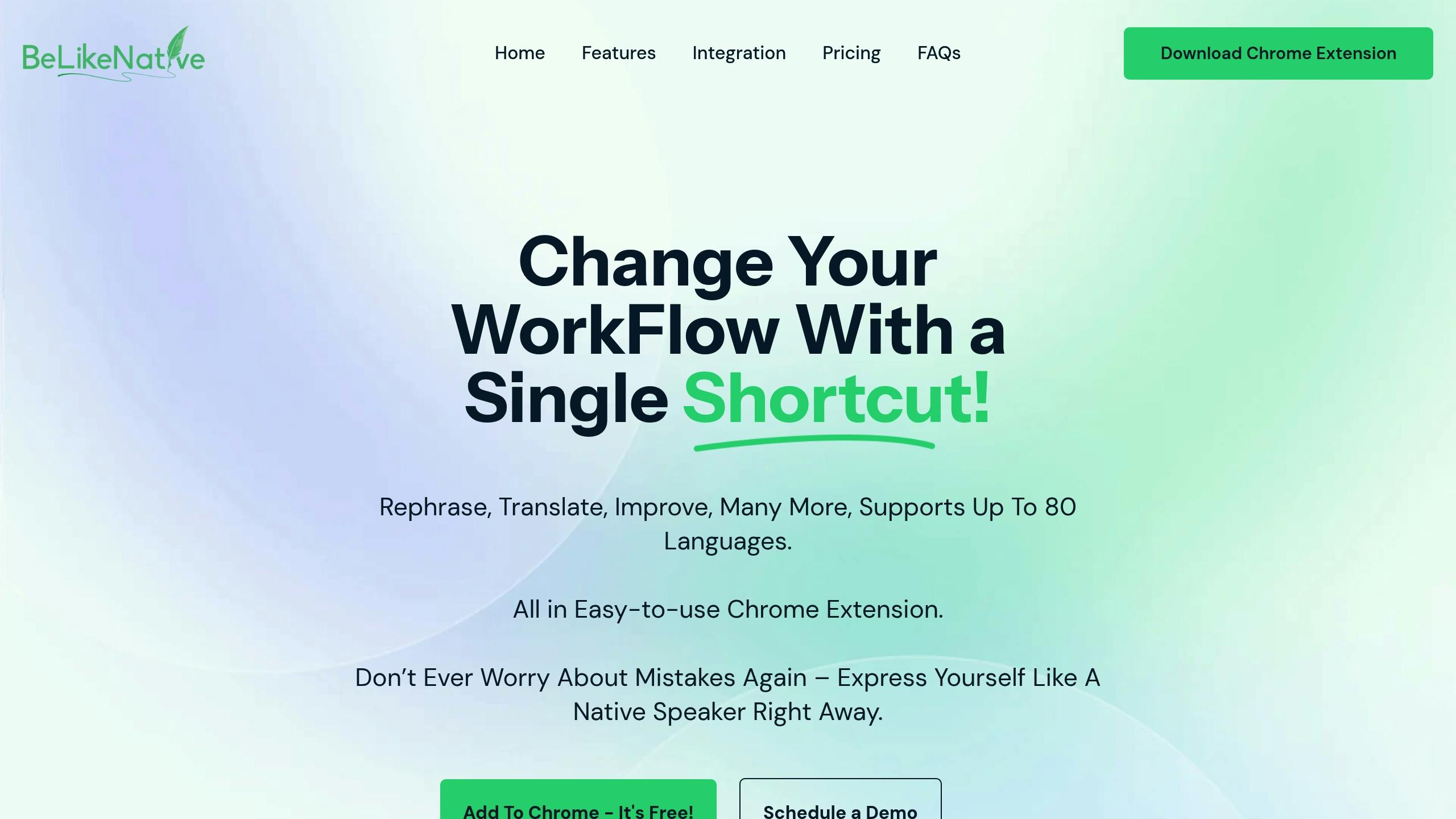How Local Trends Shape Multilingual Content Updates
How do local trends shape multilingual content updates? Local trends like seasonal habits, cultural events, and consumer behaviors directly impact how people engage with content. By aligning your message with these trends, your content feels more relevant and relatable to your audience.
Key Takeaways of Content Updates:
- Why Local Trends Matter: They influence decisions, making your content more relatable.
- Tools You Can Use: Social listening, search analytics, and market research help spot trends.
- Adapting Content: Go beyond translation – adjust tone, visuals, and even formatting for each region.
- Update System: Use tools like Google Trends and BeLikeNative for real-time updates and cultural alignment.
Content Updates: Quick Overview:
| Focus Area | Action | Outcome |
|---|---|---|
| Track Trends | Monitor tools like Google Trends | Spot emerging local interests |
| Cultural Fit | Adapt idioms, visuals, and tone | Content feels natural and relatable |
| AI Tools | Use tools like BeLikeNative | Faster, accurate, and localized updates |
| Measure Results | Track engagement and bounce rates | Refine content for better performance |
Tailoring content to local preferences isn’t just about translation – it’s about creating a connection. Dive into the article for tools and strategies to make your multilingual content resonate globally while staying locally relevant.
Multilingual Content Updates Creation: Insights from VeraContent‘s CEO

Content Updates: Finding and Using Local Market Trends
Local trends play a key role in connecting with your audience. To tap into these trends effectively, you need a clear plan for gathering and analyzing data.
Why Local Trends Matter
Local trends heavily influence how people make decisions. By weaving local customs, events, and even social media trends into your messaging, you can build stronger connections with your audience. When businesses align their content with these elements, they create messages that feel more relevant and relatable to the community.
Tools to Identify Regional Trends
To uncover local trends, you’ll need tools that provide real-time insights into what’s happening in specific areas. Here are some common tool categories:
| Tool Category | Primary Use | Key Benefits |
|---|---|---|
| Social Listening | Tracking conversations and sentiment | Offers real-time feedback and audience insights |
| Search Analytics | Monitoring regional search patterns | Highlights seasonal trends and popular topics |
| Market Research | Understanding consumer behavior | Provides demographic and purchasing data |
Many platforms also include features designed to track regional activity and engagement. These can help you spot trends before they gain broader attention.
How to Track Emerging Trends
Tracking trends involves both automated tools and human analysis. For instance, Google Trends is great for spotting patterns in regional interest, especially when paired with other data sources.
Keep an eye on:
- Engagement metrics like likes, shares, and comments
- Regional search volumes
- Competitor campaigns and their performance
Striking the right balance between maintaining your global brand identity and staying relevant locally is crucial. For multilingual campaigns, tools like BeLikeNative can ensure your content resonates across different languages and cultures. This is especially important when quick adjustments are needed to stay ahead of emerging trends. These methods naturally tie into strategies for reaching diverse audiences.
Making Content Updates Work Across Languages
Creating impactful multilingual content requires more than just translating words. It’s about understanding cultural nuances and tailoring your message to fit the preferences and expectations of each audience. This means considering how people in different regions consume and engage with content.
Checking Local Fit
After analyzing trends, ensure your content aligns with the local context. Here are some key areas to review:
| Element | Verification Steps | Key Considerations |
|---|---|---|
| Cultural Context | Review idioms and metaphors | Make sure expressions are meaningful and appropriate |
| Visual Elements | Check images and graphics | Avoid visuals that might be culturally insensitive |
| Formatting | Adjust dates and numbers | Use formats like 03/18/2025 for the US |
| Measurements | Convert units | Use miles, pounds, and Fahrenheit for the US |
Once these elements are reviewed, you can refine the tone and structure of your content for better engagement.
Adjusting Content Style
Translation alone isn’t enough to maintain your message’s effectiveness. You need to adapt the style to match local preferences while staying true to your brand’s voice. Keep these points in mind:
- Tone and CTAs: Match the tone to local communication styles and place calls to action where they align with reading habits.
- Content Length: Some audiences prefer detailed content, while others value concise information.
- Local References: Use examples and scenarios that are relevant to the culture and resonate with the audience.
Tailoring your content this way ensures it feels natural and relatable to your target audience, increasing its overall impact.
sbb-itb-32359dc
Tools for Multi-Language Content Updates
Creating multilingual content requires a balance between global messaging and local relevance. To achieve this, you need tools that can handle translation and cultural adjustments efficiently, without compromising quality.
AI Translation Tools
AI translation tools have evolved to deliver more natural results by considering context, tone, and cultural subtleties. When choosing one, focus on these key features:
| Feature | Purpose | Benefit |
|---|---|---|
| Context Analysis | Understands the surrounding content | Produces natural, accurate translations |
| Style Preservation | Keeps your brand’s tone intact | Ensures consistent messaging |
| Cultural Adaptation | Adjusts for local preferences | Connects better with your audience |
| Format Handling | Maintains formatting elements | Delivers a polished, professional look |
Trend Update Tools
To keep content relevant in different markets, use tools that track local trends and behaviors. These tools can help you adapt your messaging by monitoring:
- Social Media Patterns: Identify trending topics and hashtags in specific regions.
- Search Behavior: Analyze local search queries and popular terms.
- Content Performance: Measure how your content performs in different regions.
- Cultural Events: Stay informed about upcoming local celebrations or key dates.
Using BeLikeNative for Content Updates

BeLikeNative is a powerful tool for managing culturally relevant content across multiple languages. Its Chrome extension supports over 80 languages and lets you customize tone and style to suit local preferences. Here’s what it offers:
| Feature | Benefit |
|---|---|
| Clipboard Integration | Quickly refine text with a single shortcut. |
| Style Customization | Tailors content to match local tastes. |
| Cross-Platform Compatibility | Works seamlessly across various online platforms. |
| Extensive Language Support | Covers 80+ languages for broad accessibility. |
Pair these tools with regular trend monitoring to ensure your multilingual content remains accurate and culturally aligned.
Building an Content Update System
Developing a system to keep multilingual content aligned with local trends requires thoughtful planning and consistent effort. By using existing tools and methods, you can transform local insights into actionable updates for your content.
Setting Up Trend Tracking
A good trend tracking system blends automated tools with human expertise. To get started, focus on these essential components:
| Component | Purpose | Implementation |
|---|---|---|
| Data Sources | Monitor regional preferences | Use tools like Google Trends, social listening platforms, and local news alerts. |
| Update Frequency | Keep content up-to-date | Conduct daily monitoring, weekly analysis, and monthly updates. |
| Market Segments | Target key regions | Identify primary markets and their specific preferences. |
| KPI Tracking | Measure performance | Track metrics like engagement, conversions, and audience growth. |
Assign team members to specific regions to ensure cultural nuances are accurately captured. Once your tracking system is in place, focus on organizing these insights for updates.
Planning Content Updates
Incorporate the trends you’ve tracked into your content calendar to ensure regular updates. Keep these timing and priority considerations in mind:
| Update Type | Timing | Priority Level |
|---|---|---|
| Seasonal Events | 2-3 months ahead | High |
| Cultural Celebrations | 1-2 months ahead | High |
| Market Trends | 1-2 weeks ahead | Medium |
| Breaking Topics | Within 24-48 hours | Urgent |
Use a centralized dashboard to log trending topics and schedule updates. This approach streamlines the process and ensures updates are both timely and relevant.
Checking Update Results
After implementing updates, it’s essential to measure their impact. Use analytics to track performance and focus on these key metrics:
| Metric | Target Range | Action Threshold |
|---|---|---|
| Engagement Rate | 3-5% increase | Below 1% needs further review. |
| Time on Page | 2+ minutes | Less than 1 minute requires changes. |
| Social Shares | 10% growth | Under 5% calls for deeper analysis. |
| Bounce Rate | Below 55% | Over 65% suggests a mismatch. |
Collaborate with native speakers and local experts to ensure updates reflect cultural nuances. Regularly review performance trends to improve your strategy over time.
Mixing Global and Local Content
Balancing global consistency with local relevance helps maintain your brand identity while effectively connecting with different audiences.
Keeping Brand Voice
Develop a brand voice that stays consistent yet flexible enough to adjust to local norms. Here’s how you can align global standards with regional needs:
| Brand Element | Global Approach | Local Adaptation |
|---|---|---|
| Core Values | Stick to universal principles | Adapt how they’re expressed to fit cultural contexts |
| Tone of Voice | Retain the main brand personality | Adjust formality levels depending on the region |
| Visual Identity | Use shared design elements | Modify colors to suit local meanings |
| Key Messages | Keep central themes intact | Focus on translating ideas, not just words |
Take Nike as an example. Their “Just Do It” message resonates worldwide, but they tweak it for local markets. In Japan, the focus shifts toward collective achievement rather than individual success, all while staying true to their athletic excellence theme.
In addition to voice, using standardized templates ensures visual and structural elements align with both global standards and local preferences.
Content Updates Templates by Region
Design templates that strike a balance between brand consistency and local relevance. Focus on these core elements:
| Template Component | Purpose | Regional Considerations |
|---|---|---|
| Content Structure | Provides a basic layout | Adjust for right-to-left reading in Arabic markets |
| Image Guidelines | Sets rules for visual content | Account for local cultural sensitivities |
| Tone Matrix | Defines communication style | Tailor formality levels to each market |
| Call-to-Action Format | Drives engagement | Adapt to local purchasing habits |
Managing Multiple Languages
Once templates are ready, you’ll need efficient systems to handle language-specific updates. Pay attention to these areas:
| Management Area | Implementation | Quality Control |
|---|---|---|
| Version Control | Track updates by language | Conduct translation audits |
| Style Guides | Create market-specific writing rules | Have native speakers review content |
| Update Frequency | Follow localized content calendars | Monitor regional trends regularly |
| Quality Metrics | Measure engagement by region | Review performance monthly |
Leverage tools like BeLikeNative to ensure translations feel natural and consistent across all markets. These tools can help streamline processes and maintain quality.
Conclusion
BeLikeNative simplifies the process of tailoring content for diverse audiences with support for over 80 languages and adjustable tone settings. It helps brands deliver regional voices that feel natural and relatable. Here’s a quick look at key areas to align local insights with global strategies:
| Focus Area | Implementation Strategy | Expected Outcome |
|---|---|---|
| Trend Integration | Regularly track regional preferences | Content that connects with local audiences |
| Technology Usage | Use AI-driven translation and cultural tools | Faster, more precise content localization |
| Quality Control | Rely on native speaker reviews and data tracking | Content that stays true to your brand |
Localization goes beyond word-for-word translation. It’s about understanding cultural subtleties, local preferences, and market behaviors. BeLikeNative’s tools for rephrasing and translation ensure your message stays clear, while feeling natural to your target audience.


